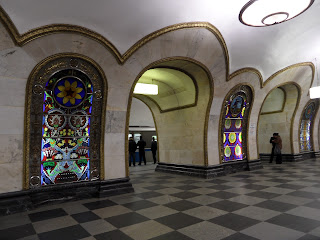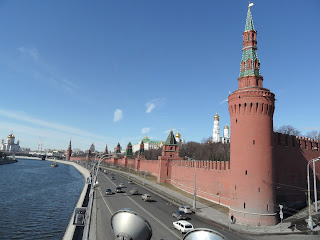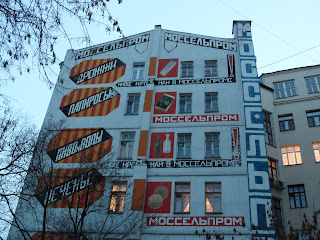Hello again!
I write this post in the middle of our week off for spring break and having just arrived back early this morning (4:11 AM) from Moscow. Amanda and I decided to take a short trip to Moscow over spring break and take in a few sites that one or both of us had not done. It was my third and Amanda's second trip to the city, but it's a big city and there is a lot to see! We took the night train from St. Petersburg Tuesday night and arrived a little after 5 AM in Moscow where we spent an activity-filled day that involved an incredible amount of walking before catching another night train back to St. Petersburg that same day. It was a tiring experience, but also a lot of fun. We have many pictures, so I will post a generous selection below and offer my own commentary. Enjoy:-)
We started the day off by visiting some of the more picturesque stations on the Moscow metro. The Moscow metro is one of the largest in the world and the second busiest (next only to Tokyo), but many of its stations are strikingly decorated. The metro was first built in the 1930s and has been expanding ever since. In the early decades in particular, the stations reflected Communist art and stand as a reminder of the ideals of Russia's Soviet past.
Even though the metro is one of the busiest in the world, we were able to get some great pictures because we arrived literally as soon as the metro opened for the morning. Later in the day it would be back to the normal packed cars and people shoving you, but for the hour from 5:30-6:30 AM it was like we were the only people in the city which was actually a very cool feeling.
The next three pictures are from Komsomolskaya Station. This is the station nearest the train station we arrived at. The ceilings are decorated with mosaics depicting events in Russian history.
The next noteworthy station we stopped at was Novoslobodskaya. The station is decorated like stained glass windows.
The next pictures are from Mayakovskaya Station. This station is decorated with a series of mosaics depicting images related to flight. It opened in 1938 is often considered to be one of the most beautiful of the stations in the metro.
The last station I'll post photos of is Ploshchad Revolutsia. This station is notable for the series of bronze statutes that line it. The statues are of people who represent various Soviet ideals like soldiers, students, farmers, scientists, and miners.
After visiting these metro stations, we made our way to Red Square primarily in search of a place to eat breakfast (McDonald's!), but once again since we were there so early the square, which is usually packed with tourists, was virtually abandoned. You can see that I'm almost the only person in the square in the next photo.
Next we visited a few notable buildings in Moscow just to see them up close. The first one is the Kudrinskaya Square Building. It is one of the
Seven Sisters (or Stalin High-rises as they are known in Russian), a series of seven skyscrapers that are more or less identical made on the orders of Stalin in the late 1940s and early 1950s. The style is usually described as "Stalinist Gothic." I wouldn't call it beautiful, but it is certainly striking. You see these buildings throughout the city as you travel around. The tallest is the Moscow State University building (about 750 feet), but we had to settle for this one:-)
The next building we went to is the
Lubyanka. The Lubyanka was the headquarters of KGB and its various other incarnations throughout Soviet history and still houses some of the offices of the FSB, the KGB's modern successor in Russia. Some of the greatest political persecutions in human history were in all probability planned inside this otherwise innocuous looking building.
The next shot is just a very nice photo Amanda took that captures the Kazan Cathedral, State Historical Museum, and one of the towers in the Kremlin wall.
Our next destination was GUM (in Russian it's an acronym for "main department store"). GUM was built during Tsarist times as a major shopping center and it continues to serve that function day, offering mostly high-end stores. While we could not afford to shop in the stores, the building itself is beautiful and is located right on Red Square.


The next sequence of photos is all of St. Basil's Cathedral, perhaps the most iconic of all Russian churches. I had been inside the Church 4 years ago, but Amanda had not yet had a chance to go in. The Church is very easy to recognize and has been reproduced in countless images around the world, but what many people do not know is that the "church" is actually a collection of nine churches connected to each other. Walking in for the first time can be a bit surprising if you are used to walking into a normal Orthodox Church were you would encounter a large open area reaching up to the domes. Instead, you find many smaller churches, each with its own beautiful iconostasis, connected to each other by dark passageways. The interior is beautiful and the different churches inside all differ from one another at least somewhat in their decorations and in the style of their iconography.









We (and by "we" I mean Amanda, who took ALL of the photos that you see here:-)) got some good photos of the walls of the Kremlin as well:
The next place we visited was the
Cathedral of Christ the Savior. The Church has a very interesting history. It was originally built during the 1800s, but was destroyed by the Soviets in the 1930s because they wanted to build an enormous Palace of Soviets on its place. However, lack of funds, flooding from the river, and the Second World War prevented this plan from being carried out. Instead, the world's largest heated outdoor swimming pool was built there. After the fall of the Soviet Union, the Russian Orthodox Church obtained permission to rebuild the Cathedral and the new building was finished in 2000 and is the tallest Orthodox Church in the world. The inside of the Church is very impressive visually, as is the Church of the Transfiguration, which is located underneath the Church. Since it is a functioning church, photography is not permitted, but we have pictures of the exterior of the church.




Visible from near the church is the Monument to Peter the Great, an enormous statue (about 300 feet tall) commemorating the founding of the Russian navy by Peter the Great. The statue is controversial for its enormous size, its dubious connection to the city (Peter the Great hated Moscow) and is considered by many to be rather ugly. The city has tried to give it away to St. Petersburg, but St. Petersburg has refused. Say what you will about it, it is certainly a very large statue.
Our next destination was the modern wing of the Tretyakov Gallery. I had been to the 19th century building before, but I had not seen the 20th century collection of the gallery, which is housed in a separate location. Russia had a thriving avant garde movement during the first quarter of the twentieth century and we both wanted to go. We didn't take any pictures there (I've never understood the inclination some people have to take pictures of paintings), but thoroughly enjoyed ourselves there.
After visiting the gallery, we went to the Arbat area of the city, which was a famous neighborhood in the past. While Arbat Street is now mostly filled with souvenir shops and restaurants, it is still a nice area and a good place to walk. We got food there and also enjoyed going to a Dunkin Donuts shop. American-style donuts are not common in Russia, so it was nice to be able to enjoy one!
I had one final place I wanted to see before we hobbled off to the train station to return home, and that was the location of the old Mosselprom building. Mosselprom was a general store of sorts during the early Soviet period. It was of interest to me because of the role that prominent Soviet artists played in designing advertising materials for it. The artist Alexander Rodchenko and the poet Vladimir Mayakovsky worked together to design advertising posters that, in contrast to the monotonous Soviet posters that would come later, are actual works of art that are still striking. The building still reflects some of the art of the time period and is an interesting reminder of a past era.
All of that in one day, not bad:-)
Thanks for reading,
- Matt





.jpg)























































